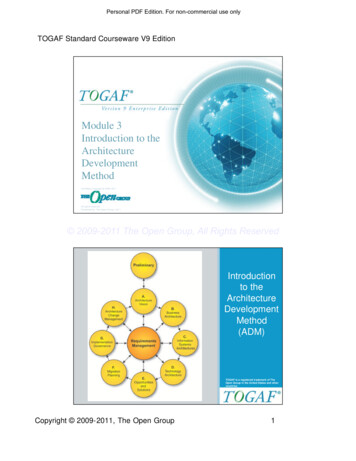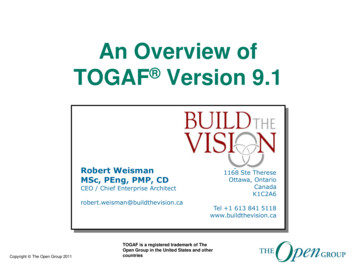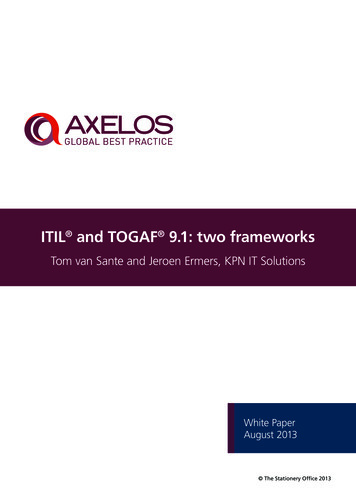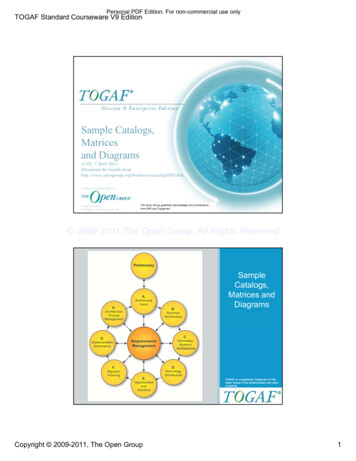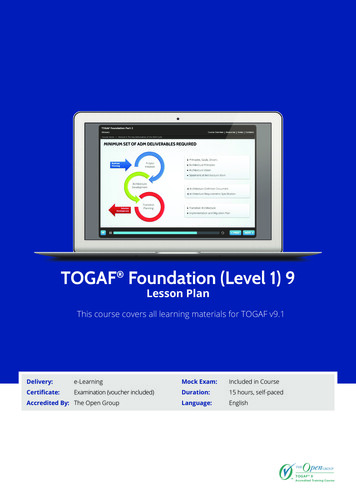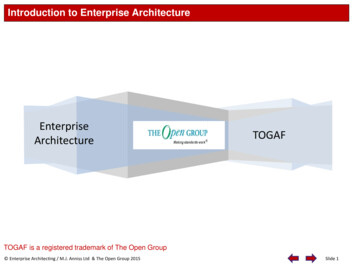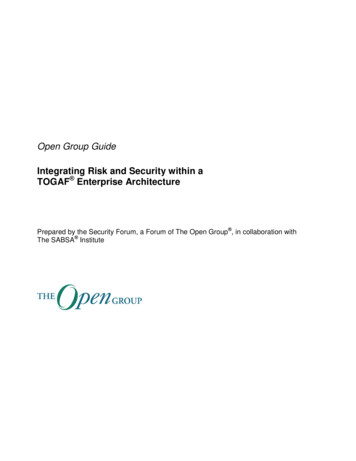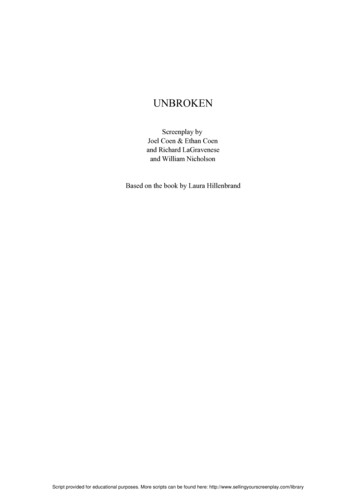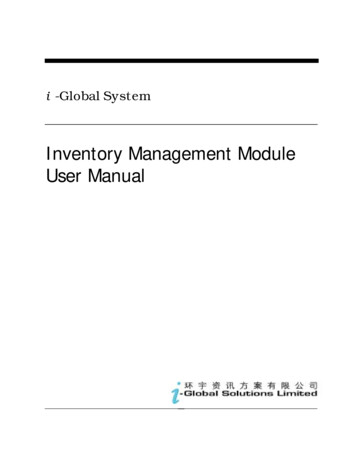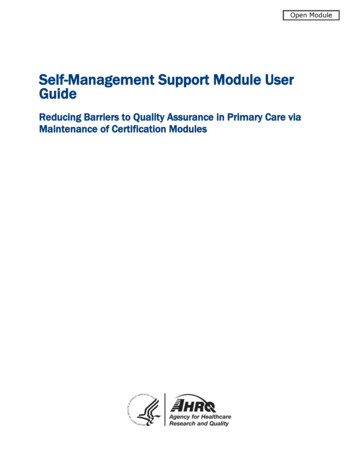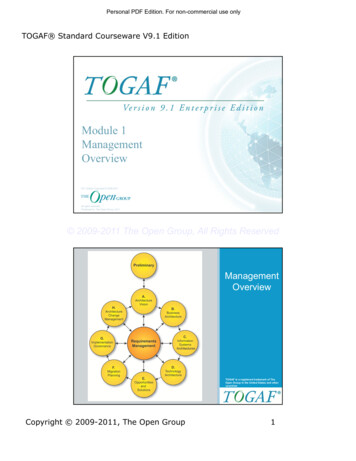
Transcription
Personal PDF Edition. For non-commercial use onlyTOGAF Standard Courseware V9.1 EditionModule 1ManagementOverviewV9.1 Edition Copyright 2009-2011Slide 1 of 67All rights reservedPublished by The Open Group, 2011 2009-2011 The Open Group, All Rights ReservedManagementOverviewTOGAF is a registered trademark of TheOpen Group in the United States and othercountriesSlide 2 of 67Copyright 2009-2011, The Open Group1
Personal PDF Edition. For non-commercial use onlyTOGAF Standard Courseware V9.1 EditionModule Objectives To provide a management overview of TOGAF, an OpenGroup Standard– The Open Group– The Architecture Forum– Why enterprise architecture– Why a framework– TOGAF 9.1– TOGAF 9 Certification– SummarySlide 3 of 67 2009-2011 The Open Group, All Rights ReservedAgenda The Open GroupThe Architecture ForumWhy Enterprise ArchitectureWhy a FrameworkTOGAF 9.1TOGAF 9 CertificationSummarySlide 4 of 67Copyright 2009-2011, The Open Group2
Personal PDF Edition. For non-commercial use onlyTOGAF Standard Courseware V9.1 EditionThe Open Group Is an international vendor - and technology – neutralconsortium that organizations rely on to lead thedevelopment of IT standards and certifications Provides guidance and open environment to enableinteroperability and vendor-neutrality Membership is open to all enterprises, small, medium andlarge, anywhere in the worldSlide 5 of 67 2009-2011 The Open Group, All Rights ReservedOur VisionBoundaryless Information Flow achieved through global interoperabilityin a secure, reliable and timely manner“Boundaryless does not mean there are noboundaries – it means that boundaries arepermeable to enable business.”Slide 6 of 67Copyright 2009-2011, The Open Group3
Personal PDF Edition. For non-commercial use onlyTOGAF Standard Courseware V9.1 EditionOur MissionThe mission of The Open Group is to drive thecreation of Boundaryless Information Flow achieved by: Working with customers to capture,understand and address current and emergingrequirements, establish policies, and share bestpractices; Working with suppliers, consortia andstandards bodies to develop consensus andfacilitate interoperability, to evolve and integratespecifications and open source technologies; Offering a comprehensive set of services toenhance the operational efficiency of consortia;and Developing and operating the industry'spremier certification service and encouragingthe procurement of certified products.Slide 7 of 67 2009-2011 The Open Group, All Rights ReservedTackling BoundarylessInformation FlowWhitePapersStandardsProduct &servicecertificationPeople &professionalcertificationEnterprise ArchitectureCloud ComputingInteroperabilityPortability of applicationsReal-time and EmbeddedSystemsSecurity, compliance, identityand risk managementService Oriented ArchitectureTrusted technologySlide 8 of 67Copyright 2009-2011, The Open Group4
Personal PDF Edition. For non-commercial use onlyTOGAF Standard Courseware V9.1 EditionActivities Governing Board work groups– Open CA Work Group– Open CITS Work Group– UNIX Work Group Member Forums–––– Architecture, ArchiMate Enterprise Management, PlatformReal Time & Embedded, Security and Identity ManagementTrusted Technology Forum, Jericho ForumWork Groups––––Business ArchitectureCloud ComputingQuantum LifecycleSemantic Interoperability, including Universal Data Element Framework(UDEF)– Service Oriented Architecture (SOA)Slide 9 of 67 2009-2011 The Open Group, All Rights ReservedForums/Work Areas ofThe Open Group Meeting points for Suppliers and Buyers Each Forum is effectively an autonomous consortiumoperating within The Open Group– Direction determined by members– Outputs approved by members– Must obey some rules to respect anti-trust legislation Forums initiate new areas of work, often in partnership withother Forums– leading to industry standards– leading to certification programs based on those standardsSlide 10 of 67Copyright 2009-2011, The Open Group5
Personal PDF Edition. For non-commercial use onlyTOGAF Standard Courseware V9.1 EditionHow members work Mostly virtual– E-mail, teleconference, web conference Collaboration infrastructure– Track activities for projects, forums etc Quarterly Global Member Meetings Local Member MeetingsKey DeliverablesOpen Standards Professional Process and methodology Software, technicalCertification of conformance to standardsConferences and events – global and localSlide 11 of 67 2009-2011 The Open Group, All Rights ReservedWhy “Customers” join We can build relationships with peers inour or other industries and shareknowledge We can talk to suppliers in a non-sellingenvironmentWe can influence the priorities beingaddressed by the industryWe have early access to the solutions beingdeveloped to address our urgent issuesWe can track forums, work groups, projectsand activities that are relevant to our enterpriseSlide 12 of 67Copyright 2009-2011, The Open Group6
Personal PDF Edition. For non-commercial use onlyTOGAF Standard Courseware V9.1 EditionThe Open Group Open CITSSkillsOpen onEnterprise ssSlide 13 of 67 2009-2011 The Open Group, All Rights ReservedAgenda The Open GroupThe Architecture ForumWhy Enterprise ArchitectureWhy a FrameworkTOGAF 9TOGAF 9 CertificationSummarySlide 14 of 67Copyright 2009-2011, The Open Group7
Personal PDF Edition. For non-commercial use onlyTOGAF Standard Courseware V9.1 EditionArchitecture Forum – Mission The mission of The Open Group Architecture Forum is toadvance The Open Group vision of BoundarylessInformation Flow, for and between enterprises, Through a set of programs that focus on all architecturalaspects, including:– Providing broad and deep leadership to the EA community– Validating, publishing, fostering, and maintaining best practices forEA– Developing, organizing, researching, and publishing thought leadersin EA– Initiating and managing programs and projects to support theseactivitiesSlide 15 of 67 2009-2011 The Open Group, All Rights ReservedStakeholders and Value Customer Architects– reduced time, cost, risk Tools Vendors– bigger market, bigger market share IT Solution Vendors– greater cost-efficiency Integrators– greater cost-efficiency, better service Academic /Research Organizations– funding supportSlide 16 of 67Copyright 2009-2011, The Open Group8
Personal PDF Edition. For non-commercial use onlyTOGAF Standard Courseware V9.1 EditionAgenda The Open GroupThe Architecture ForumWhy Enterprise ArchitectureWhy a FrameworkTOGAF 9TOGAF 9 CertificationSummarySlide 17 of 67 2009-2011 The Open Group, All Rights ReservedWhat is an Enterprise? A collection of organizations that share a common set ofgoals– Government agency– Part of a corporation– Corporation Large corporations may comprise multiple enterprises May be an “extended enterprise” including partners,suppliers and customersSlide 18 of 67Copyright 2009-2011, The Open Group9
Personal PDF Edition. For non-commercial use onlyTOGAF Standard Courseware V9.1 EditionWhat is an Architecture? An Architecture is thefundamental organization ofsomething, embodied in:– its components,– their relationships to eachother and the environment,– and the principles governingits design and evolution.Adapted from ANSI/IEEE Standard 1471-2000Slide 19 of 67 2009-2011 The Open Group, All Rights ReservedWhat is Enterprise Architecture?[1] MIT Center for Information Systems Research[2] SearchCIO.comEnterprise Architecture is: The organizing logic for businessprocesses and IT infrastructurereflecting the integration andstandardization requirements ofthe firm’s operating model.[1] A conceptual blueprint thatdefines the structure andoperation of an organization.The intent of an enterprisearchitecture is to determine howan organization can mosteffectively achieve its currentand future objectives. [2]Slide 20 of 67Copyright 2009-2011, The Open Group10
Personal PDF Edition. For non-commercial use onlyTOGAF Standard Courseware V9.1 EditionArchitecture TechnologyArchitectureSlide 21 of 67 2009-2011 The Open Group, All Rights ReservedWhy Enterprise Architecture? Effective management and exploitation of informationthrough IT is key to business success Good information management competitive advantage Current IT systems do not really meet the needs ofbusiness– Fragmented, duplicated– Poorly understood– Not responsive to change Investment in Information Technology– Focussed on system maintenance– Tactical developments rather than a strategic planSlide 22 of 67Copyright 2009-2011, The Open Group11
Personal PDF Edition. For non-commercial use onlyTOGAF Standard Courseware V9.1 EditionWhy Enterprise Architecture? Two key reasons why you need an enterprisearchitecture:– Critical to business survival and success– Enables managed innovation within the enterpriseSlide 23 of 67 2009-2011 The Open Group, All Rights ReservedPressure to develop EnterpriseArchitecture Laws and regulations– Clinger-Cohen Act (US Information TechnologyManagement Reform Act 1996)– EU Directives on the Award of Public Contracts– Sarbanes-Oxley More extended enterprises More co-operative IT operations Greater publicity to failures Increase in litigation Audit requirementsSlide 24 of 67Copyright 2009-2011, The Open Group12
Personal PDF Edition. For non-commercial use onlyTOGAF Standard Courseware V9.1 EditionBusiness Benefits of EnterpriseArchitecture It helps an organization achieve its business strategy Faster time to market for new innovations and capabilities More consistent business processes and information acrossbusiness units More reliability and security, less riskSource: “Why Enterprise Architecture Matters?”, The Open Group White Paper, W076Slide 25 of 67 2009-2011 The Open Group, All Rights ReservedBusiness Benefits of EnterpriseArchitecture A more efficient business operationA more efficient IT operationBetter return on existing investment,Reduced risk for future investmentFaster, simpler, and cheaper procurementSee also: “Why Enterprise Architecture Matters?”, The Open Group White Paper, W076Slide 26 of 67Copyright 2009-2011, The Open Group13
Personal PDF Edition. For non-commercial use onlyTOGAF Standard Courseware V9.1 EditionThe Importance of Governance An Enterprise Architecture isonly as good as the decisionmaking framework that isestablished around it Æ”governance” framework The Governance Frameworkdepends on– Clear authority structure– The right participantsSlide 27 of 67 2009-2011 The Open Group, All Rights ReservedWhat do we mean by Governance? The way in which decisions are made Who is responsible? Who is involved? Who is accountable?Slide 28 of 67Copyright 2009-2011, The Open Group14
Personal PDF Edition. For non-commercial use onlyTOGAF Standard Courseware V9.1 EditionAgenda The Open GroupThe Architecture ForumWhy Enterprise ArchitectureWhy a FrameworkTOGAF 9TOGAF 9 CertificationSummarySlide 29 of 67 2009-2011 The Open Group, All Rights ReservedWhat is an Architecture Framework? Definition 3.13: Architecture Framework– A conceptual structure used to develop, implement and sustain anenterprise architecture It should describe a method for designing target state of theenterprise in terms of a set of building blocks, and forshowing how the building blocks fit together It should contain a set of tools and provide a commonvocabulary It should also include a list of recommended standards andcompliant products that can be used to implement thebuilding blocksSlide 30 of 67Copyright 2009-2011, The Open Group15
Personal PDF Edition. For non-commercial use onlyTOGAF Standard Courseware V9.1 EditionThe Value of a Framework Provides a practical starting point for an Architecture Project– Avoids the initial panic when the scale of the taskbecomes apparent– Systematic – “Codified common sense”– Captures what others have found to work in real life– Contains a Baseline set of resources for reuseSlide 31 of 67 2009-2011 The Open Group, All Rights ReservedEnterprise Architecture Development MethodA comprehensivegeneral methodComplementary to, notcompeting with, otherframeworksWidely adopted in themarketTailorable to meet anorganization andindustry needsAvailable under a freeperpetual licenseVendor, tool andtechnology neutralopen standardAvoids re-inventing thewheelBusiness IT alignmentBased in best practicesPossible to participatein the evolution of theframeworkSlide 32 of 67Copyright 2009-2011, The Open Group16
Personal PDF Edition. For non-commercial use onlyTOGAF Standard Courseware V9.1 EditionAgenda The Open GroupThe Architecture ForumWhy Enterprise ArchitectureWhy a FrameworkTOGAF 9.1TOGAF 9 CertificationSummarySlide 33 of 67 2009-2011 The Open Group, All Rights ReservedTOGAF Origins A customer initiative A framework, not an architecture– A generic framework for developing architectures tomeet different business needs– Not a “one-size-fits-all” architecture Originally based on TAFIM (U.S. DoD)Slide 34 of 67Copyright 2009-2011, The Open Group17
Personal PDF Edition. For non-commercial use onlyTOGAF Standard Courseware V9.1 EditionTOGAF Development1994RequirementProof of need1995TOGAF Version 1Proof of concept1996TOGAF Version 2Proof of application1997TOGAF Version 3Relevance to practical architectures(building blocks)1998TOGAF Version 4Enterprise Continuum (TOGAF incontext)1999TOGAF Version 5Business Scenarios (architecturerequirements)2000TOGAF Version 6Architecture Views (IEEE Std 1471)Slide 35 of 67 2009-2011 The Open Group, All Rights ReservedTOGAF Development2001TOGAF Version 7Architecture Principles; ComplianceReviews2002TOGAF Version 8Extension to Enterprise Architecture2003TOGAF Version 8.1Requirements Management;Governance; Maturity Models; SkillsFramework2006TOGAF Version 8.1.1 Technical Corrigendum 1 applied2009TOGAF Version 9Evolutionary restructure; ArchitectureContent Framework2011TOGAF Version 9.1Technical Corrigendum 1 appliedSlide 36 of 67Copyright 2009-2011, The Open Group18
Personal PDF Edition. For non-commercial use onlyTOGAF Standard Courseware V9.1 EditionMember (End User) Driven Customer members demand architecture standards Customer members select TAFIM as preferred starting point DoD Information Systems Agency (DISA) donate TAFIM as base TOGAF first published‘93‘94‘96‘01 TOGAF 7 – Technical Edition‘02 ‘03‘06‘09TOGAF 9 EnterpriseEdition‘11TOGAF 9.1TOGAF 8.1.1 The Interoperable EnterpriseBusiness Scenariofirst publishedTOGAF 8 – Enterprise EditionFirst TOGAF CertificationProgram LaunchedSlide 37 of 67 2009-2011 The Open Group, All Rights ReservedTOGAF Scope TOGAF emphasizes business goals as architecture drivers,and provides a repository of best practice, including:––––––TOGAF Architecture Development Method (ADM)ADM Guidelines & TechniquesTOGAF Architecture Content FrameworkEnterprise ContinuumTOGAF Reference ModelsTOGAF Capability FrameworkSlide 38 of 67Copyright 2009-2011, The Open Group19
Personal PDF Edition. For non-commercial use onlyTOGAF Standard Courseware V9.1 EditionTOGAF Goals Long-term:– An industry standard, generic enterprise architecture method .– .usable on its own or in conjunction with frameworks havingproducts relevant/specific to particular sectors. Several frameworks have mind share:– Zachman, Spewak, DoD Framework, FEAF, TEAF, Almost all focus on products, not method TOGAF and . (not TOGAF or .) Version 9:– An evolution from TOGAF 8.1.1. Closer alignment with thebusiness. Restructuring for ease of use. Overall structure andcore method for enterprise architecture that can be filled out infuture years.Slide 39 of 67 2009-2011 The Open Group, All Rights ReservedTOGAF 9 ComponentsADMADM Guidelines& TechniquesArchitecture ContentFrameworkEnterprise ContinuumReference ModelsArchitecture CapabilityFrameworkSlide 40 of 67Copyright 2009-2011, The Open Group20
Personal PDF Edition. For non-commercial use onlyTOGAF Standard Courseware V9.1 EditionTOGAF 9.1 StandardPart I - IntroductionPreface, Executive Overview, Core Concepts, Definitions andRelease NotesPart II – Architecture Development MethodIntroduction to ADMADM Phase NarrativesPart III – ADM Guidelines and TechniquesGuidelines for Adapting the ADM ProcessTechniques for Architecture DevelopmentPart IV – Architecture Content FrameworkArchitecture Content MetamodelArchitectural ArtifactsArchitecture DeliverablesBuilding BlocksPart V – Enterprise Continuum and ToolsEnterprise ContinuumArchitecture PartitioningArchitecture RepositoryTools for Architecture DevelopmentPart VI – TOGAF Reference ModelsFoundation Architecture: Technical Reference ModelIntegrated Information Infrastructure Reference ModelPart VII – Architecture Capability FrameworkArchitecture BoardArchitecture ComplianceArchitecture ContractsArchitecture GovernanceArchitecture Maturity ModelsArchitecture Skills FrameworkSlide 41 of 67 2009-2011 The Open Group, All Rights ReservedTOGAF 9 Components Architecture Development Method (ADM)– An iterative sequence of steps to develop an enterprise-widearchitecture ADM Guidelines and Techniques– Guidelines and techniques to support the application of the ADM Architecture Content Framework– A detailed model of architectural work products, includingdeliverables, artifacts within deliverables, and the ArchitectureBuilding Blocks (ABBs) that deliverables represent.Slide 42 of 67Copyright 2009-2011, The Open Group21
Personal PDF Edition. For non-commercial use onlyTOGAF Standard Courseware V9.1 EditionTOGAF 9 Components The Enterprise Continuum– A model for structuring a virtual repository and methods forclassifying architecture and solution artifacts TOGAF Reference Models:– The TOGAF Technical Reference Model (TRM)– The Integrated Information Infrastructure Model (III-RM). The Architecture Capability Framework– A structured definition of the organizations, skills, roles andresponsibilities to establish and operate an Enterprise Architecture.Slide 43 of 67 2009-2011 The Open Group, All Rights ReservedModular StructureContent FrameworkExtended GuidanceArchitectural StylesAdditional ADM detailTOGAF Capability FrameworkInforms thecapabilityArchitecture CapabilityFramework (Part VII)Ensures RealizationDrives need forArchitecture Capabilitymaturityof Business VisionBusiness needsfeed into methodBusinessVision andDriversRefinesUnderstandingArchitecture DevelopmentMethod (Part II)of the current stateDelivers newbusiness solutionsADM Guidelines &Techniques (Part III)ArchitectureContent Framework(Part IV)Informs the BusinessSets targets, KPIs,budgets forarchitecture rolesEnterprise Continuum &Tools (Part V)TOGAF ReferenceModels (Part VI)BusinessCapabilitiesTOGAF ADM &Content FrameworkOperational changescause updatesTOGAF EnterpriseContinuum & ToolsSlide 44 of 67Copyright 2009-2011, The Open Group22
Personal PDF Edition. For non-commercial use onlyTOGAF Standard Courseware V9.1 EditionADM – Basic PrinciplesAn iterative method, over the wholeprocess, between phases and withinphasesEach iteration new decisions:Enterprise coverageLevel of detailTime horizonArchitecture asset re-use:previous ADM iterationsother frameworks, systemmodels, industry models, Decisions based on:Competence / resource availabilityValue accruing to the enterprise.Slide 45 of 67 2009-2011 The Open Group, All Rights ReservedADM – Basic PrinciplesEvery phase is validatedagainst and validates thecurrent requirements of thebusinessSlide 46 of 67Copyright 2009-2011, The Open Group23
Personal PDF Edition. For non-commercial use onlyTOGAF Standard Courseware V9.1 EditionPreliminary Phase This phase includes thepreparation and initiationactivities to create anArchitecture Capability– Understand businessenvironment– High level managementcommitment– Agreement on scope– Establish principles– Establish governancestructure– Customization of TOGAFSlide 47 of 67 2009-2011 The Open Group, All Rights ReservedPhase AArchitecture Vision Initiates one iteration of thearchitecture process– Sets scope, constraints,expectations– Required at the start ofevery architecture cycle Create the ArchitectureVision Validates business context Creates Statement ofArchitecture workSlide 48 of 67Copyright 2009-2011, The Open Group24
Personal PDF Edition. For non-commercial use onlyTOGAF Standard Courseware V9.1 EditionPhase BBusiness Architecture The fundamentalorganization of a business,embodied in– its business processesand people,– their relationships to each other and theenvironment,– and the principles governing its design andevolutionShows how the organizationmeets its business goalsSlide 49 of 67 2009-2011 The Open Group, All Rights ReservedBusinessArchitecture - Contents Organization structure Business goals andobjectives Business functions Business Services Business processes Business roles Correlation of organizationand functions.Slide 50 of 67Copyright 2009-2011, The Open Group25
Personal PDF Edition. For non-commercial use onlyTOGAF Standard Courseware V9.1 EditionBusinessArchitecture - Steps1. Select reference models,viewpoints and tools2. Define Baseline ArchitectureDescription3. Define Target ArchitectureDescription4. Perform gap analysis5. Define candidate roadmapcomponents6. Conduct formal stakeholderreview7. Finalize the Architecture8. Create ArchitectureDefinition DocumentSlide 51 of 67 2009-2011 The Open Group, All Rights ReservedPhase CInformation Systems Architectures The fundamentalorganization of an IT system,embodied in The major types ofinformation andapplications that processthem relationships to eachother and theenvironment, and theprinciples governing itsdesign and evolution Shows how the IT systemsmeets the business goals ofthe enterpriseContinuedSlide 52 of 67Copyright 2009-2011, The Open Group26
Personal PDF Edition. For non-commercial use onlyTOGAF Standard Courseware V9.1 EditionData or Applicationsfirst ? It is usually necessary toaddress both Not always the case,depending on project scopeand constraintsMay be developed in eitherorder, or in parallel Theory suggests DataArchitecture comes first Practical considerationsmay mean that starting withApplication Architecturemay be more efficientThere will need to be someiteration to ensure consistencySlide 53 of 67 2009-2011 The Open Group, All Rights ReservedPhase DTechnology Architecture The fundamentalorganization of an IT system,embodied in its hardware, softwareand communicationstechnology their relationships toeach other and theenvironment, and the principlesgoverning its design andevolutionSlide 54 of 67Copyright 2009-2011, The Open Group27
Personal PDF Edition. For non-commercial use onlyTOGAF Standard Courseware V9.1 EditionPhase EOpportunities and Solutions Perform initialimplementation planning Identify the majorimplementation projects Determine if an incrementalapproach is required, if sodefine TransitionArchitectures Decide on approach Make v Buy v Re-Use Outsource COTS Open Source Assess priorities Identify dependenciesSlide 55 of 67 2009-2011 The Open Group, All Rights ReservedPhase FMigration Planning For work packages andprojects identified in Phase Eperform Cost/benefit analysis Risk assessment Finalize a detailedImplementation andMigration PlanSlide 56 of 67Copyright 2009-2011, The Open Group28
Personal PDF Edition. For non-commercial use onlyTOGAF Standard Courseware V9.1 EditionPhase GImplementation Governance Provide architecturaloversight for theimplementation. Defines architectureconstraints onimplementation projects Govern and manage anArchitecture contract Monitors implementationwork for conformance Produce a Business ValueRealization.Slide 57 of 67 2009-2011 The Open Group, All Rights ReservedPhase HArchitecture Change Management Provide continual monitoringand a change managementprocess Ensures that changes to thearchitecture are managed ina cohesive and architectedway Establishes and supports theEnterprise Architecture toprovide flexibility to evolverapidly in response tochanges in the technology orbusiness environment Monitors the business andcapacity management.Slide 58 of 67Copyright 2009-2011, The Open Group29
Personal PDF Edition. For non-commercial use onlyTOGAF Standard Courseware V9.1 EditionAgenda The Open GroupThe Architecture ForumWhy Enterprise ArchitectureWhy a FrameworkTOGAF 9.1TOGAF 9 CertificationSummarySlide 59 of 67 2009-2011 The Open Group, All Rights ReservedTOGAF CertificationCertificationLevelPurposeTOGAF 9FoundationTo provide validation that the candidate hasgained knowledge of the terminology and basicconcepts of TOGAF 9 and understands the coreprinciples of Enterprise Architecture and TOGAFTOGAF 9CertifiedTo provide validation that in addition to knowledgeand comprehension, the candidate is able toanalyze and apply knowledge of TOGAFSlide 60 of 67Copyright 2009-2011, The Open Group30
Personal PDF Edition. For non-commercial use onlyTOGAF Standard Courseware V9.1 EditionTOGAF FoundationTarget Audience Individuals who require a basic understanding of TOGAF9 Professionals who are working in roles associated with anarchitecture project such as those responsible forplanning, execution, development, delivery and operation Architects who are looking for a first introduction toTOGAF 9 Architects who want to achieve Level 2 certification in astepwise approach.Slide 61 of 67 2009-2011 The Open Group, All Rights ReservedTOGAF CertifiedTarget Audience Individuals who require a deeper understanding ofTOGAF 9; Professionals who are working in an organization whereTOGAF 9 has been adopted and who need to participatein architecture projects and initiatives; Architects who will be responsible for developingarchitecture artifacts; Architects who wish to introduce TOGAF 9 into anarchitecture practice; Architects who want to achieve a recognized qualificationto demonstrate their detailed knowledge of TOGAF 9.Slide 62 of 67Copyright 2009-2011, The Open Group31
Personal PDF Edition. For non-commercial use onlyTOGAF Standard Courseware V9.1 EditionSome Figures about TOGAF Developed by 300 organisations worldwide involved inits development– Large IT users– IT vendors– System Integrators– Academics Used in major IT projects worldwide– IBM, HP, Sun, Infosys, . Community of knowledgeable TOGAF practitioners– More than 16000 certified Supported by Architecture ToolsSlide 63 of 67 2009-2011 The Open Group, All Rights ReservedAgenda The Open GroupThe Architecture ForumWhy Enterprise ArchitectureWhy a FrameworkTOGAF 9.1TOGAF 9 CertificationSummarySlide 64 of 67Copyright 2009-2011, The Open Group32
Personal PDF Edition. For non-commercial use onlyTOGAF Standard Courseware V9.1 EditionTOGAF 9 Summary An effective, industry standard framework and methodfor enterprise architecture. Complementary to, not competing with, other enterpriseframeworks A repository of best practice– “Demystifies” architecture development Vendor, tool, and technology neutral A framework and method for achieving the“Boundaryless Information Flow” visionSlide 65 of 67 2009-2011 The Open Group, All Rights ReservedFor More Information . . . The TOGAF Web Site– http://www.opengroup.org/togaf/ The Architecture Forum– http://www.opengroup.org/architecture/ TOGAF Version 9.1 on-line– rch/ TOGAF Version 9.1 licensing and downloads– http://www.opengroup.org/togaf/Slide 66 of 67Copyright 2009-2011, The Open Group33
Personal PDF Edition. For non-commercial use onlyTOGAF Standard Courseware V9.1 EditionManagementOverviewTOGAF is a registered trademark of TheOpen Group in the United States and othercountriesSlide 67 of 67 2009-2011 The Open Group, All Rights ReservedCopyright 2009-2011, The Open Group34
1999 TOGAF Version 5 Enterprise Continuum (TOGAF in context) 1998 TOGAF Version 4 1995 TOGAF Version 1 Proof of concept 2000 TOGAF Version 6 Architecture Views (IEEE Std 1471) Relevance to practical architectures (building blocks) 1997 TOGAF Version 3 1996 TOGAF Version 2 Proof of applicatio
